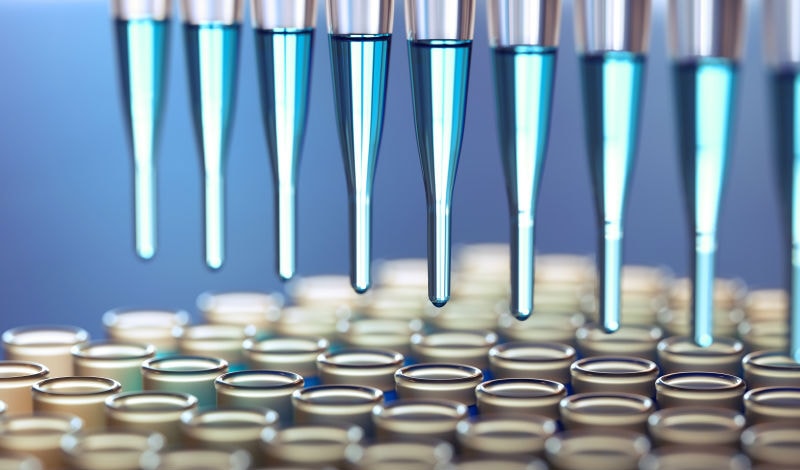
Automated Liquid Handling systems have contributed to the rearrangement of research workflows, which has further led to off-putting the manual efforts that are typically involved in liquid transfer operations. Automated liquid handling reflects a set of equipment and instruments that are used for handling liquids and implementing functions relating to liquid transfer within a clinical and research arena.
Intuitive interfaces of automated liquid handling systems enable operators of any skill level to perform their daily tasks effortlessly and with confidence. The systems provide full control of a highly flexible automation. Automated liquid handling systems reduce time spent on repetitive pipetting tasks. They offer systems that are best suitable for medium or high applications along with meeting multiple liquid handling requisites which include channels, liquid volumes, or microplate type. Decreasing sample contamination and improving accuracy in bioassays is possible with these systems. Manual intervention into research often comes coupled with errors and is not reproducible. It further creates supplementary bottlenecks within the encompassed research experiment when tryouts are not satisfactorily reproduced. These concerns have highlighted the adoption of automated liquid handling systems since their implementation ensures error-free reproducible results.
Full Report: https://www.kbvresearch.com/automated-liquid-handling-market/
Why are Automated Liquid Handling (ALH) systems crucial?
Since multiple variables are affecting the important process in laboratories, choosing the appropriate solution for small volume handling is extremely important. Therefore, numerous labs have turned to automated liquid handling systems to complement improved reliability and increased efficiency to lab processes. One of the key benefits of automated liquid handlers is that they eradicate both person-to-person and day-to-day variability. Further, they generally accomplish this through minimized training that is needed to manually hand out sub-microliter volumes. Automated liquid handles also enable combination with other processing instruments. Through this, automated liquid handlers can be improved to accomplish better results and can be calibrated as per factors like the liquid type.
Types of Automated Liquid Handling Systems:
Individual Benchtop Workstation
Individual benchtop workstations are tools that are designed to perform most of the sampling, mixing, and amalgamating liquid samples automatically. Bioresearch laboratories and drug development labs have limited sample contamination and free personnel to perform other tasks by using a multipurpose liquid handling automated workstation. The workstations are capable of measuring samples, add reagents, and ensure that liquids are added to bioassays in a uniform way. In comparison with other liquid handling systems, benchtop workstations are emerging as one of the top selling products across the globe.
ALH in PCR setup
The automation of PCR setup upsurges reproducibility alongside reducing hands-on time. Automated liquid handlers enable rapid and accurate setup of endpoint, real-time, and multiplex PCR experiments. With platform sizes including benchtop and largely integrated workstations, any throughput requirements can be entertained. Automated liquid handlers offer solutions for any PCR automation needs.
ALH in Serial Dilution
Serial dilutions are a commonly used application in a lab. The user pipettes concentrated sample into the desired location and fill a series of additional locations which contain a fixed amount of diluent. Lab automation is the most appropriate choice for simplifying serial dilutions along with assuring utmost accuracy. A multi-channel automated pipettor has the capability of carrying out serial dilutions of eight to twelve samples simultaneously.
ALH in Plate Reformatting
Owing to the surging liquid handling constraints, sample reformatting turns out to be an expensive process. Plate reformatting is the process in which samples are moved from one container to another. The flow must be carefully performed to avoid unnecessary container format changes. Automated liquid handlers are used for compound management. These offer full plate dilutions and reformatting from source plates to assay plates.
Trends & Developments
Liquid handling robots are being used in automating chemical and biochemical laboratories. The robots dispense a specific quantity of reagent, samples, or other liquids into a designated container. Several liquid handling workstations can conduct multiple lab unit operations like sample mixing, transport, manipulation, and incubation. Liquid handling robots are available in the market with customizations using different add-on modules like PCR machines, colony pickers, etc. Manufacturers are emphasizing on developing automated liquid handling workstations to mix, sample, and combine the liquids. Automated liquid handling systems extend the range from semi-automated multichannel pipettors to room-sized systems. The industry is evolving toward nifty, modular systems for every budget. Similarly, instrumentation, software, and methods are following the trend toward superior user accessibility.
Click Here For Free Insights: https://www.kbvresearch.com/news/automated-liquid-handling-market-size/